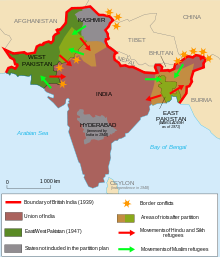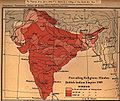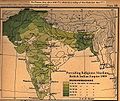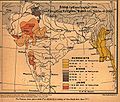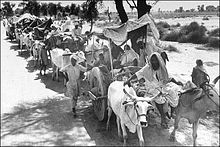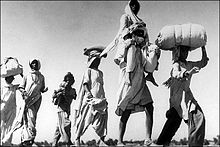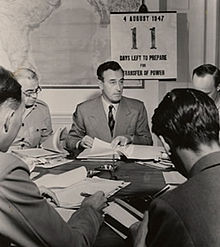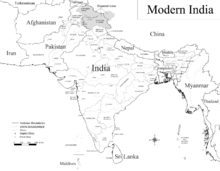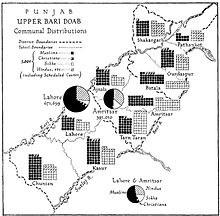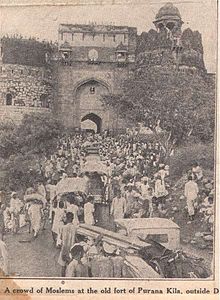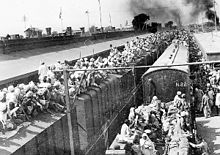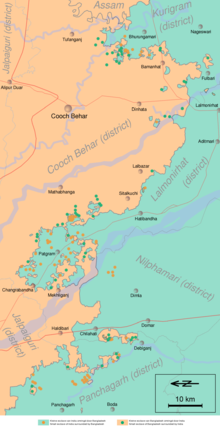- Partition of India
-
Colonial India 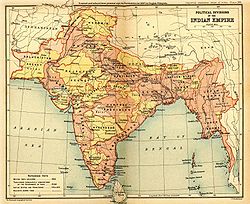
British Indian EmpireColonial India Portuguese India 1510–1961 Dutch India 1605–1825 Danish India 1620–1869 French India 1759–1954 British India 1613–1947 East India Company 1612–1757 Company rule in India 1757–1857 British Raj 1858–1947 British rule in Burma 1824–1942 Princely states 1765–1947/48 Partition of India 1947 The Partition of India (Hindi: हिंदुस्तान का बटवारा (Devanagari) Hindustān ka Batwārā, Hindustani: ہندوستان کی تقسیم (Nastaleeq) Hindustān ki Taqseem) was the partition of British India on the basis of religious demographics that led to the creation on 15 August 1947 of the sovereign states of the Dominion of Pakistan (later the Islamic Republic of Pakistan and the People's Republic of Bangladesh) and the Union of India (later Republic of India).
promulgated in the Indian Independence Act 1947 and resulted in the dissolution of the British Indian Empire. The struggle between the new dominions of India and Pakistan which resulted from the partition displaced up to 12.5 million people in the former British Indian Empire, with estimates of loss of life varying from several hundred thousand to a million.[1] The violent nature of the partition created an atmosphere of mutual hostility and suspicion between India and Pakistan that plagues their relationship to this day.
The partition of India included the geographical division of the Bengal province of British India into East Bengal, which became part of the Dominion of Pakistan (from 1956, East Pakistan, until independence as Bangladesh in 1971) and West Bengal, which became part of India; and the similar partition of the Punjab province into West Punjab (later the Pakistani Punjab and Islamabad Capital Territory) and East Punjab (later the Indian Punjab, Haryana and Himachal Pradesh). The partition deal also included the division of Indian government assets, including the Indian Civil Service, the Indian Army, the Royal Indian Navy, the Indian railways and the central treasury, and other administrative services.
In the aftermath of Partition, the princely states of India, which had been left by the Indian Independence Act 1947 to choose whether to accede to India or Pakistan or to remain outside them,[2] were all incorporated into one or other of the new dominions, in almost all cases by the ruler signing as instrument of accession. The question of the choice to be made in this connection by Jammu and Kashmir led to the Indo-Pakistani War of 1947 and other wars and conflicts between India and Pakistan.[3]
Contents
India and Pakistan
Two self governing countries legally came into existence at the stroke of midnight on 15 August 1947. The ceremonies for the transfer of power were held a day earlier in Karachi, at the time the capital of the new state of Pakistan, so that the last British Viceroy, Lord Mountbatten of Burma, could attend both the ceremony in Karachi and the ceremony in Delhi. This is why Pakistan's Independence Day is celebrated on August 14 and India's on August 15.
Background
Late nineteenth and early twentieth century
The All India Muslim League (AIML) was formed in Dhaka in 1906 by Muslims who were suspicious of the Hindu-majority Indian National Congress. They complained that Muslim members did not have the same rights as Hindu members. A number of different scenarios were proposed at various times. Among the first to make the demand for a separate state was the writer/philosopher Allama Iqbal, who, in his presidential address to the 1930 convention of the Muslim League said that a separate nation for Muslims was essential in an otherwise Hindu-dominated subcontinent.
The Sindh Assembly passed a resolution making it a demand in 1935. Iqbal, Jouhar and others then worked hard to draft Mohammad Ali Jinnah, who had till then worked for Hindu-Muslim unity, to lead the movement for this new nation. By 1930, Jinnah had begun to despair of the fate of minority communities in a united India and had begun to argue that mainstream parties such as the Congress, of which he was once a member, were insensitive to Muslim interests.
The 1932 Communal Award which seemed to threaten the position of Muslims in Hindu-majority provinces catalysed the resurgence of the Muslim League, with Jinnah as its leader. However, the League did not do well in the 1937 provincial elections, demonstrating the hold of the conservative and local forces at the time.
1932–1942
In 1940, Jinnah made a statement at the Lahore conference that seemed to call for a separate Muslim 'nation'. However, the document was ambiguous and opaque, and did not evoke a Muslim nation in a territorial sense. This idea, though, was taken up by Muslims and particularly Hindus in the next seven years, and given a more territorial element. All Muslim political parties including the Khaksar Tehrik of Allama Mashriqi opposed the partition of India[4] Mashriqi was arrested on 19 March 1940.
Hindu organisations such as the Hindu Mahasabha, though against the division of the country, were also insisting on the same chasm between Hindus and Muslims. In 1937 at the 19th session of the Hindu Mahasabha held at Ahmedabad, Veer Savarkar in his presidential address asserted:[5]
“ India cannot be assumed today to be Unitarian and homogeneous nation, but on the contrary there are two nations in the main — the Hindus and the Muslims. ” Most of the Congress leaders were secularists and resolutely opposed the division of India on the lines of religion. Mohandas Gandhi and Allama Mashriqi believed that Hindus and Muslims could and should live in amity. Gandhi opposed the partition, saying,
“ My whole soul rebels against the idea that Hinduism and Islam represent two antagonistic cultures and doctrines. To assent to such a doctrine is for me a denial of God. ” For years, Gandhi and his adherents struggled to keep Muslims in the Congress Party (a major exit of many Muslim activists began in the 1930s), in the process enraging both Hindu Nationalists and Indian Muslim nationalists. (Gandhi was assassinated soon after Partition by Hindu nationalist Nathuram Godse, who believed that Gandhi was appeasing Muslims at the cost of Hindus.)
Politicians and community leaders on both sides whipped up mutual suspicion and fear, culminating in dreadful events such as the riots during the Muslim League's Direct Action Day of August 1946 in Kolkata (then "Calcutta"), in which more than 5,000 people were killed and many more injured. As public order broke down all across northern India and Bengal, the pressure increased to seek a political partition of territories as a way to avoid a full-scale civil war.
1942–1946
Until 1946, the definition of Pakistan as demanded by the League was so flexible that it could have been interpreted as a sovereign nation Pakistan, or as a member of a confederated India.
Some historians believe Jinnah intended to use the threat of partition as a bargaining chip in order to gain more independence for the Muslim dominated provinces in the west from the Hindu-dominated center.[6]
Other historians claim that Jinnah's real vision was for a Pakistan that extended into Hindu-majority areas of India, by demanding the inclusion of the East of Punjab and West of Bengal, including Assam, a Hindu-majority country. Jinnah also fought hard for the annexation of Kashmir, a Muslim majority state with Hindu ruler; and the accession of Hyderabad and Junagadh, Hindu-majority states with Muslim rulers.[citation needed]
The British colonial administration did not directly rule all of "India". There were several different political arrangements in existence: Provinces were ruled directly and the Princely States with varying legal arrangements, like paramountcy.
The British Colonial Administration consisted of Secretary of State for India, the India Office, the Governor-General of India, and the Indian Civil Service. The British were in favour of keeping the area united. The 1946 Cabinet Mission was sent to try and reach a compromise between Congress and the Muslim League. A compromise proposing a decentralized state with much power given to local governments won initial acceptance, but Nehru was unwilling to accept such a decentralized state and Jinnah soon returned to demanding an independent Pakistan.[7]
The Indian political parties were:
- All India Muslim League
- Communist Party of India
- Majlis-e-Ahrar-ul-Islam
- Hindu Mahasabha
- Indian National Congress
- Khaksar Tehrik
- Unionist Muslim League (mainly in the Punjab).
The Partition: 1947
Mountbatten Plan
The actual division between the two new dominions was done according to what has come to be known as the 3 June Plan or Mountbatten Plan.
Within British India, the border between India and Pakistan (the Radcliffe Line) was determined by a British Government-commissioned report prepared under the chairmanship of a London barrister, Sir Cyril Radcliffe. Pakistan came into being with two non-contiguous enclaves, East Pakistan (today Bangladesh) and West Pakistan, separated geographically by India. India was formed out of the majority Hindu regions of British India, and Pakistan from the majority Muslim areas.
On 18 July 1947, the British Parliament passed the Indian Independence Act that finalized the arrangements for partition and abandoned British suzerainty over the princely states, of which there were several hundred, leaving them free to choose whether to accede to one of the new dominions. The Government of India Act 1935 was adapted to provide a legal framework for the new dominions.
Following its independence, Pakistan applied for membership of the United Nations and was accepted by the General Assembly on 30 September 1947. The union formed from the combination of the non-Muslim provinces of British India with a large number of princely states assumed the name India, which automatically gave it the seat of the old India (a UN member since 1945) as a successor state.[8]
Geography of the partition: the Radcliffe Line
The Punjab — the region of the five rivers east of Indus: Jhelum, Chenab, Ravi, Beas, and Sutlej — consists of interfluvial doabs, or tracts of land lying between two confluent rivers. These are the Sind-Sagar doab (between Indus and Jhelum), the Jech doab (Jhelum/Chenab), the Rechna doab (Chenab/Ravi), the Bari doab (Ravi/Beas), and the Bist doab (Beas/Sutlej) (see map). In early 1947, in the months leading up to the deliberations of the Punjab Boundary Commission, the main disputed areas appeared to be in the Bari and Bist doabs, although some areas in the Rechna doab were claimed by the Congress and Sikhs. In the Bari doab, the districts of Gurdaspur, Amritsar, Lahore, and Montgomery (Sahiwal) were all disputed.[9]
All districts (other than Amritsar, which was 46.5% Muslim) had Muslim majorities; albeit, in Gurdaspur, the Muslim majority, at 51.1%, was slender. At a smaller area-scale, only three tehsils (sub-units of a district) in the Bari doab had non-Muslim majorities. These were: Pathankot (in the extreme north of Gurdaspur, which was not in dispute), and Amritsar and Tarn Taran in Amritsar district. In addition, there were four Muslim-majority tehsils east of Beas-Sutlej (with two where Muslims outnumbered Hindus and Sikhs together).[9]
Before the Boundary Commission began formal hearings, governments were set up for the East and the West Punjab regions. Their territories were provisionally divided by "notional division" based on simple district majorities. In both the Punjab and Bengal, the Boundary Commission consisted of two Muslim and two non-Muslim judges with Sir Cyril Radcliffe as a common chairman.[9]
The mission of the Punjab commission was worded generally as:
“ To demarcate the boundaries of the two parts of the Punjab, on the basis of ascertaining the contiguous majority areas of Muslims and non-Muslims. In doing so, it will take into account other factors.[9] ” Each side (the Muslims and the Congress/Sikhs) presented its claim through counsel with no liberty to bargain. The judges too had no mandate to compromise and on all major issues they "divided two and two, leaving Sir Cyril Radcliffe the invidious task of making the actual decisions."[9]
Massive population exchanges occurred between the two newly formed states in the months immediately following Partition. Once the lines were established, about 14.5 million people crossed the borders to what they hoped was the relative safety of religious majority. Based on 1951 Census of displaced persons, 7,226,000 Muslims went to Pakistan from India while 7,250,000 Hindus, Sikhs and Jews moved to India from Pakistan immediately after partition. However the net flow of Muslims is from Pakistan to India. It means more Muslims in Pakistan have chosen to come and stay in India than Muslims in India have chosen to move to Pakistan. About 11.2 million or 78% of the population transfer took place in the west, with Punjab accounting for most of it; 5.3 million Muslims moved from India to West Punjab in Pakistan, 3.4 million Hindus and Sikhs moved from Pakistan to East Punjab in India; elsewhere in the west 1.2 million moved in each direction to and from Sind.[citation needed]The newly formed governments were completely unequipped to deal with migrations of such staggering magnitude, and massive violence and slaughter occurred on both sides of the border. Estimates of the number of deaths range around roughly 500,000, with low estimates at 200,000 and high estimates at 1,000,000.[10]
Punjab
The Indian state of East Punjab was created in 1947, when the Partition of India split the former British province of Punjab between India and Pakistan. The mostly Muslim western part of the province became Pakistan's Punjab Province; the mostly Sikh and Hindu eastern part became India's East Punjab state. Many Hindus and Sikhs lived in the west, and many Muslims lived in the east, and the fears of all such minorities were so great that the partition saw many people displaced and much intercommunal violence.
Lahore and Amritsar were at the centre of the problem, the Boundary Commission was not sure where to place them - to make them part of India or Pakistan. The Commission decided to give Lahore to Pakistan, whilst Amritsar became part of India. Some areas in west Punjab, including Lahore, Rawalpindi, Multan, and Gujrat, had a large Sikh & Hindu population, and many of the residents were attacked or killed. On the other side, in East Punjab, cities such as Amritsar, Ludhiana, and Gurdaspur had a majority Muslim population, many of whom were killed by the Sikhs and Hindus or emigrated.
Bengal
The province of Bengal was divided into the two separate entities of West Bengal belonging to India, and East Bengal belonging to Pakistan. East Bengal was renamed East Pakistan in 1955, and later became the independent nation of Bangladesh after the Bangladesh Liberation War of 1971.
While the Muslim majority district of Murshidabad was given to India, the Hindu majority district of Khulna and the Buddhist majority Chittagong division was given to Pakistan by the award.
Sindh
Hindu Sindhis were expected to stay in Sindh following Partition, as there were good relations between Hindu and Muslim Sindhis. At the time of Partition there were 1,400,000 Hindu Sindhis, though most were concentrated in cities such as Hyderabad, Karachi, Shikarpur, and Sukkur. However, because of an uncertain future in a Muslim country, a sense of better opportunities in India, and most of all a sudden influx of Muslim refugees from Gujarat, Uttar Pradesh, Bihar, Rajputana (Rajasthan) and other parts of India, many Sindhi Hindus decided to leave for India.
Problems were further aggravated when incidents of violence instigated by Indian Muslim refugees broke out in Karachi and Hyderabad. According to the census of India 1951, nearly 776,000 Sindhi Hindus moved into India.[11] Unlike the Punjabi Hindus and Sikhs, Sindhi Hindus did not have to witness any massive scale rioting; however, their entire province had gone to Pakistan thus they felt like a homeless community. Despite this migration, a significant Sindhi Hindu population still resides in Pakistan's Sindh province where they number at around 2.28 million as per Pakistan's 1998 census while the Sindhi Hindus in India as per 2001 census of India were at 2.57 million.[citation needed]
Jammu & Kashmir
The Princely state of Kashmir and Jammu had a majority Muslim population; Muslims were 80 percent of whole state. The Maharaja of Jammu and Kashmir acceded to India at the outbreak of violence. This Kashmir conflict led to the 1947 war between India and Pakistan in that region.
Hyderabad
The Hyderabad State had a majority Hindu population; the Nizam wanted to accede to Pakistan or if that was not possible remain independent. However such a decision was unacceptable to India, so in 1948 Indian Armed Forces engaged those of the State of Hyderabad and ended the rule of Nizam, annexing the state into the Indian Union.
Laccadive Islands
Under the British, the Laccadives, later to be renamed the Lakshadweep Islands, formed part of the Malabar district of the Madras Presidency of British India, the whole of which transferred to the new Dominion of India. However, the islands had a substantial Muslim majority, causing Sardar Patel to fear that the new state of Pakistan might seek to lay claim to them, even though they were remote from all parts of Pakistan. The inhabitants of the islands were cut off from the mainstream of the country and only received confirmation of Indian Independence some days after 15 August 1947. Patel sent a Royal Indian Navy ship to the islands to hoist the Indian national flag, aiming to thwart any attempt by Pakistan to seize the islands. Only hours later, vessels belonging to the Royal Pakistan Navy were sighted near the islands, but they retreated after seeing the Indian naval presence and the Indian flag flying.[12]
Perspectives
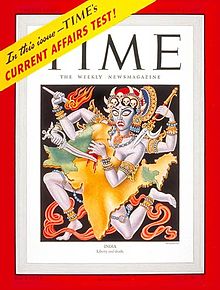 TIME magazine 27 October 1947 cover Boris Artzybasheff depicting a self-hurting goddess Kali as a symbol of the partition of India. The caption says: "INDIA: Liberty and death."
TIME magazine 27 October 1947 cover Boris Artzybasheff depicting a self-hurting goddess Kali as a symbol of the partition of India. The caption says: "INDIA: Liberty and death."
The Partition was a highly controversial arrangement, and remains a cause of much tension on the subcontinent today. The British Viceroy, Lord Mountbatten of Burma has not only been accused of rushing the process through, but also is alleged to have influenced the Radcliffe Line in India's favour since everyone agreed India would be a more desirable country for most.[13][14] However, the commission took so long to decide on a final boundary that the two nations were granted their independence even before there was a defined boundary between them. Even then, the members were so distraught at their handiwork (and its results) that they refused compensation for their time on the commission.[citation needed]
Some critics allege that British haste led to the cruelties of the Partition.[15] Because independence was declared prior to the actual Partition, it was up to the new governments of India and Pakistan to keep public order. No large population movements were contemplated; the plan called for safeguards for minorities on both sides of the new border. It was a task at which both states failed. There was a complete breakdown of law and order; many died in riots, massacre, or just from the hardships of their flight to safety. What ensued was one of the largest population movements in recorded history. According to Richard Symonds:[16]
“ At the lowest estimate, half a million people perished and twelve million became homeless. ” However, some argue that the British were forced to expedite the Partition by events on the ground.[17]
“ Once in office, Mountbatten quickly became aware if Britain were to avoid involvement in a civil war, which seemed increasingly likely, there was no alternative to partition and a hasty exit from India. [17] ” Law and order had broken down many times before Partition, with much bloodshed on both sides. A massive civil war was looming by the time Mountbatten became Viceroy. After the Second World War, Britain had limited resources,[18] perhaps insufficient to the task of keeping order. Another viewpoint is that while Mountbatten may have been too hasty he had no real options left and achieved the best he could under difficult circumstances.[19] The historian Lawrence James concurs that in 1947 Mountbatten was left with no option but to cut and run. The alternative seemed to be involvement in a potentially bloody civil war from which it would be difficult to get out.[20]
Conservative elements in England consider the partition of India to be the moment that the British Empire ceased to be a world power, following Curzon's dictum that:
“ While we hold on to India, we are a first-rate power. If we lose India, we will decline to a third-rate power. ” Delhi Punjabi refugees
Refugees on train roof during Partition
An estimated 25 million Hindus, Muslims and Sikhs (1947–present) crossed the newly drawn borders to reach their new homelands. These estimates are based on comparisons of decadal censuses from 1941 and 1951 with adjustments for normal population growth in the areas of migration. In northern India - undivided Punjab and North Western Frontier Province (NWFP) - nearly 12 million were forced to move from as early as March 1947 following the Rawalpindi violence.
Delhi received the largest number of refugees for a single city - the population of Delhi grew rapidly in 1947 from under 1 million (917.939) to a little less than 2 million (1.744.072) between the period 1941-1951.[21] The refugees were housed in various historical and military locations such as the Purana Qila, Red Fort, and military barracks in Kingsway (around the present Delhi university). The latter became the site of one of the largest refugee camps in northern India with more than 35,000 refugees at any given time besides Kurukshetra camp near Panipat.
The camp sites were later converted into permanent housing through extensive building projects undertaken by the Government of India from 1948 onwards. A number of housing colonies in Delhi came up around this period like Lajpat Nagar, Rajinder Nagar, Nizamuddin East, Punjabi Bagh, Rehgar Pura, Jungpura and Kingsway Camp.
A number of schemes such as the provision of education, employment opportunities, easy loans to start businesses, were provided for the refugees at all-India level. The Delhi refugees, however, were able to make use of these facilities much better than their counterparts elsewhere.[22]
Refugees settled in India
Many Sikhs and Hindu Punjabis settled in the Indian parts of Punjab and Delhi. Hindus migrating from East Pakistan (now Bangladesh) settled across Eastern India and Northeastern India, many ending up in close-by states like West Bengal, Assam, and Tripura. Some migrants were sent to the Andaman islands where Bengali today form the largest linguistic group.
Hindu Sindhis found themselves without a homeland. The responsibility of rehabilitating them was borne by their government. Refugee camps were set up for Hindu Sindhis.
Many refugees overcame the trauma of poverty, though the loss of a homeland has had a deeper and lasting effect on their Sindhi culture. In 1967 Government of India recognized as Sindhi as a fifteenth official language of India in two scripts.
In late 2004, the Sindhi diaspora vociferously opposed a Public Interest Litigation in the Supreme Court of India which asked the Government of India to delete the word "Sindh" from the Indian National Anthem (written by Rabindranath Tagore prior to the partition) on the grounds that it infringed upon the sovereignty of Pakistan.
Refugees settled in Pakistan
In the aftermath of partition, a huge population exchange occurred between the two newly formed states. About 14.5 million people crossed the borders, including 7,226,000 Muslims came to Pakistan from India while 7,249,000 Hindus and Sikhs moved to India from Pakistan. About 5.5 million settled in Punjab Pakistan and around 1.5 million settled in Sindh.
Most of those refugees who settled in Punjab Pakistan came from Indian Punjab, Haryana, Himachal Pradesh, Jammu and Kashmir and Rajasthan. Most of those refugees who arrived in Sindh came from northern and central urban centers of India, Uttar Pradesh, Bihar, Madhya Pradesh, Gujarat and Rajasthan via Wahga and Munabao border, however a limited number of muhajirs also arrived by air and on ships. People who wished to go to India from all over Sindh awaited their departure to India by ship at the Swaminarayan temple in Karachi and were visited by Muhammad Ali Jinnah, the founder of Pakistan.[23]
The majority of Urdu speaking refugees who migrated after the independence were settled in the port city of Karachi in southern Sindh and in the cities of Hyderabad, Sukkur, Nawabshah and Mirpurkhas. As well the above many Urdu-speakers settled in the cities of Punjab mainly in Lahore, Multan, Bahawalpur and Rawalpindi. The number of migrants in Sindh was placed at over 540,000 of whom two-third were urban. In case of Karachi, from a population of around 400,000 in 1947, it turned into more than 1.3 million in 1953.
Former President of Pakistan, General Pervez Musharraf, was born in the Nahar Vali Haveli in Daryaganj, Delhi, India. Several previous Pakistani leaders were also born in regions that are in India. Pakistan's first prime minister, Liaquat Ali Khan was born in Karnal (now in Haryana). The 7-year longest-serving Governor and martial law administrator of Pakistan's largest province, Balochistan, General Rahimuddin Khan, was born in the pre-dominantly Pathan city of Kaimganj, which now lies in Uttar Pradesh. General Muhammad Zia-ul-Haq, who came to power in a military coup in 1977, was born in Jalandhar, East Punjab. The families of all four men opted for Pakistan at the time of Partition.
Aftermath
India and Pakistan
Main article: Indo-Pakistani wars and conflictsSince Partition, with the riots and killings between the two religious communities, India and Pakistan have struggled to maintain normal relations. One of the biggest debates occurs over the disputed region of Kashmir, over which there have been three wars, and the reasons for the wars have related only to the confusion over partition. There have been four Indo-Pakistani wars:
- Indo-Pakistani War of 1947: Pakistani backed tribals-army i.e. Khyber Rifles and troops invaded the princely state of Kashmir by the request of its people, which had just acceded to India by the decision of its ruler, Hari Singh, despite the fact it had a Muslim majority who want to join Pakistan. The United Nations established a stalemate and asked for fresh Referendum which was halted by Indian Government still yet.
- Indo-Pakistani War of 1965: Pakistani-backed guerrillas invaded Indian administered Kashmir. India is generally believed to have had the upper hand when a ceasefire was called. Whereas Pakistan believe its air-superiority over army and navy against India in the war to be key achievement and future success if war continues.[24]
- Indo-Pakistani War of 1971: After India announced support for the Bengalis in East Pakistan, Pakistan launched air strikes against India. India eventually captured 13,000 square kilometres of Pakistan's territory (which it later returned by International pressure). East Pakistan was partitioned from West Pakistan through the creation of Bangladesh.
- 1999 Kargil Conflict: Pakistani troops and militants invaded Indian administered Kashmir during the winter when high mountain posts were unoccupied. India recaptured all territory lost with heavy damage and called more army from New Delhi to defeat Pakistan Army of Kashmir Sector.[25]
India and Pakistan have also engaged in a nuclear arms race which has in recent times threatened to erupt into nuclear war.
The British-Tibetan border, winding as it did through the Himalayas, had never been definitively surveyed or marked. India, as the inheritor of a long stretch of the British borders, and the People's Republic of China, which invaded Tibet, eventually clashed, leading to the 1962 Sino-Indian War.
International
Violence between Hindus and Muslims did not end with the Partition. Bengali Hindus and Muslims alike were massacred in the 1971 Bangladesh atrocities. Hindus remaining in Pakistan have been persecuted[26][27] (see Hinduism in Pakistan, 2006 Lahore temple demolition and Communal violence in Pakistan). Similarly, Muslims in India have experienced repeated episodes of communal violence,[28] such as the 2002 Gujarat violence (see Communal Violence in India).
Integration of refugee populations with their new countries did not always go smoothly. Some Urdu speaking Muslims (Muhajirs)who migrated to Pakistan have complained that they are discriminated against in government employment. Municipal political conflict in Karachi, Pakistan's largest city, often pitted native Sindhis against immigrants. Sindhi, Bengali, and Punjabi refugees in India also experienced poverty as they largely came empty handed. However, 50 years after Partition, almost all ex-refugees have managed to rebuild their lives.
All of the three nations resulting from the Partition of India have had to deal with endemic civil conflicts. Inside India, these have been largely due to inter-religious unrest and disruptive far left forces. Civil unrest inside India includes:
- Civil conflict in the Seven Sister States of northeastern India
- Naxalite unrest in Andhra Pradesh (India)
- The Sikh separatist movement of the 1980s which has since become almost nonexistent.[29]
- Islamist separatist movement in Jammu & Kashmir resulting in the ethnic cleansing[30][31][32][33][34][35] of Kashmiri Hindus and massacres against Hindus such as the ones in Wandhama and Kaluchak. It has been found with enough evidence that the Pakistani government and its intermediaries have tacitly backed and armed these militants[36][37][38]
The last example of unrest, the terrorism in Kashmir, is related to the ongoing Kashmir conflict and relates to the both India and Pakistan.
Within Pakistan, unrest is mainly because of ethnicities, with Sindhis, Bengalis, Balochis and Pashtuns, all vying for more representation within Pakistan and in some cases, the creation of an independent state.
- In 1971, Bangladesh Liberation War and the subsequent Indo-Pakistani War of 1971 which led to further partition of Pakistan.
- The Mohajir movement in Pakistan and riots in Karachi
- The Balochistan conflict in Pakistan
- The Pashtunistan movement in Pakistan
- The Waziristan conflict in Pakistan
Current religious demographics of India proper and former East and West Pakistan
Despite the huge migrations during and after Partition, India is still home to the third largest Muslim population in the world (after Indonesia and Pakistan). The current estimates for India (see Demographics of India) are as shown below. Islamic Pakistan, the former West Pakistan, by contrast, has a much smaller minority population. Its religious distribution is below (see Demographics of Pakistan). As for Bangladesh, the former East Pakistan, the non-Muslim share is somewhat larger (see Demographics of Bangladesh):
India (2006 Est. 1,095 million vs. 1951 Census 361 million)
- 80.5% Hindus (839 million)
- 13.10% Muslims (143 million)
- 2.31% Christians (25 million)
- 2.00% Sikhs (21 million)
- 1.94% Buddhists, Jains, Parsis and others (20 million)
Pakistan (2005 Est. 162 million vs. 1951 Census 34 million)
- 98.0% Muslims (159 million)
- 1.0% Christians (1.62 million)
- 1.0% Hindus, Sikhs and others (1.62 million)
Bangladesh (2005 Est. 144 million vs. 1951 Census 42 million)
- 86% Muslims (124 million)
- 13% Hindus (18 million)
- 1% Christians, Buddhists and Animists (1.44 million)
Both nations have to a great extent assimilated the refugees.
Artistic depictions of the Partition
In addition to the enormous historical literature on the Partition, there is also an extensive body of artistic work (novels, short stories, poetry, films, plays, paintings, etc.) that deals imaginatively with the pain and horror of the event.[39]
See also
- British East India Company
- British India
- List of Indian Princely States
- Indian independence movement
- Pakistan Movement
- East Bengal
- History of Bangladesh
- History of India
- History of Pakistan
- Indo-Pakistani War of 1947
- India (disambiguation)
References
- ^ Metcalf & Metcalf 2006, pp. 221–222
- ^ Revised Statute from The UK Statute Law Database: Indian Independence Act 1947 (c.30) at opsi.gov.uk
- ^ Alastair Lamb, Kashmir: A Disputed Legacy, 1846-1990, Roxford Books 1991, ISBN 0-907129-06-4
- ^ Nasim Yousaf: Hidden Facts Behind British India’s Freedom: A Scholarly Look into Allama Mashraqi and Quaid-e-Azam’s Political Conflict
- ^ V.D.Savarkar, Samagra Savarkar Wangmaya Hindu Rasthra Darshan (Collected works of V.D.Savarkar) Vol VI, Maharashtra Prantik Hindusabha, Poona, 1963, p 296
- ^ Jalal, Ayesha Jalal (1985). The Sole Spokesman: Jinnah, The Muslim League and the Demand Pakistan. Cambridge University Press.
- ^ Wolpert, Stanley. A New History of India.
- ^ Thomas R. G. C., 'Nations, States, and Secession: Lessons from the Former Yugoslavia', in Mediterranean Quarterly, Volume 5 Number 4 (Duke University Press, Fall 1994), pp. 40–65
- ^ a b c d e (Spate 1947, pp. 126–137)
- ^ Death toll in the partition
- ^ Markovits, Claude (2000). The Global World of Indian Merchants, 1750-1947. Cambridge University Press. pp. 278. ISBN 0521622859.
- ^ Gopal K. Bhargava, S. C. Bhatt (2006). Land and people of Indian states and union territories: in 36 volumes. Lakshadweep. Gyan Publishing House. pp. 232. ISBN 8178353911. http://books.google.co.in/books?id=eLSqp6EMxWAC&dq=.Page 29
- ^ K. Z. Islam, 2002, The Punjab Boundary Award, Inretrospect
- ^ Partitioning India over lunch, Memoirs of a British civil servant Christopher Beaumont
- ^ Stanley Wolpert, 2006, Shameful Flight: The Last Years of the British Empire in India, Oxford University Press, ISBN 0-19-515198-4
- ^ Richard Symonds, 1950, The Making of Pakistan, London, OCLC 245793264, p 74
- ^ a b Lawrence J. Butler, 2002, Britain and Empire: Adjusting to a Post-Imperial World, p 72
- ^ Lawrence J. Butler, 2002, Britain and Empire: Adjusting to a Post-Imperial World, p 72
- ^ Ronald Hyam, Britain's Declining Empire: The Road to Decolonisation, 1918-1968, page 113; Cambridge University Press, ISBN 0521866499, 2007
- ^ Lawrence James, Rise and Fall of the British Empire
- ^ Census of India, 1941 and 1951.
- ^ Kaur, Ravinder (2007). Since 1947: Partition Narratives among Punjabi Migrants of Delhi. Oxford University Press. ISBN 9780195683776.
- ^ Vazira Fazila-Yacoobali Zamindar (2007). The long partition and the making of modern South Asia. Columbia University Press. http://books.google.co.uk/books?id=EfhqQLr96VgC&dq=&cad=0. Retrieved 22 May 2009. Page 52
- ^ The 1965 war with Pakistan - Encyclopædia Britannica
- ^ India encircles rebels on Kashmir mountaintop, CNN
- ^ US Congress religious freedom report on Pakistan, 2006
- ^ US Congress religious freedom report on Pakistan, 2004
- ^ Hashimpura Muslim Massacre Trial Reopens: Can Justice Be Expected?, Azim A.K. Sherwani, 26 September 2006
- ^ Kumar, Ram Narayan, et al., Reduced to Ashes: The Insurgency and Human Rights in Punjab, p. IV.
- ^ The Kashmiri Pandits: An Ethnic Cleansing the World Forgot,South Asia Terrorism Portal
- ^ Back to roots: Kashmiri Pandit youth fight back,Rediff.com
- ^ Kashmir's Ethnic Cleansing & the Strangling of Tolerant Islam
- ^ The South Asian Overlooked and ignored - Kashmiri Hindus
- ^ Panun Kashmir
- ^ Rediff Has the peace process forgotten the Pandits
- ^ http://www.cfr.org/publication/11644/
- ^ http://www.fas.org/news/pakistan/1994/940622-pak.htm
- ^ http://www.dailytimes.com.pk/default.asp?page=story_14-6-2005_pg1_4
- ^ "Films & Partition train of History". The Tribune. August 5, 2007. http://www.tribuneindia.com/2007/20070805/spectrum/main1.htm.
Further reading
- Popularizations
- Collins, Larry and Dominique Lapierre: Freedom at Midnight. London: Collins, 1975. ISBN 0-00-638851-5
- Zubrzycki, John. (2006) The Last Nizam: An Indian Prince in the Australian Outback. Pan Macmillan, Australia. ISBN 978-0-3304-2321-2.
- Memoir
- Azad, Maulana Abul Kalam: India Wins Freedom, Orient Longman, 1988. ISBN 81-250-0514-5
- Academic textbooks and monographs
- Ansari, Sarah. 2005. Life after Partition: Migration, Community and Strife in Sindh: 1947—1962. Oxford, UK: Oxford University Press. 256 pages. ISBN 019597834X.
- Butalia, Urvashi. 1998. The Other Side of Silence: Voices from the Partition of India. Durham, NC: Duke University Press. 308 pages. ISBN 0822324946
- Chatterji, Joya. 2002. Bengal Divided: Hindu Communalism and Partition, 1932—1947. Cambridge and New York: Cambridge University Press. 323 pages. ISBN 0521523281.
- Chester, Lucy P. 2009. Borders and Conflict in South Asia: The Radcliffe Boundary Commission and the Partition of Punjab. Manchester University Press. ISBN 9780719078996.
- Gilmartin, David. 1988. Empire and Islam: Punjab and the Making of Pakistan. Berkeley: University of California Press. 258 pages. ISBN 0520062493.
- Gossman, Partricia. 1999. Riots and Victims: Violence and the Construction of Communal Identity Among Bengali Muslims, 1905-1947. Westview Press. 224 pages. ISBN 0813336252
- Hansen, Anders Bjørn. 2004. "Partition and Genocide: Manifestation of Violence in Punjab 1937-1947", India Research Press. ISBN 9788187943259.
- Hasan, Mushirul (2001), India's Partition: Process, Strategy and Mobilization, New Delhi: Oxford University Press, 444 pages, ISBN 0195635043.
- Ikram, S. M. 1995. Indian Muslims and Partition of India. Delhi: Atlantic. ISBN 8171563740
- Jain, Jasbir (2007), Reading Partition, Living Partition, Rawat Publications, 338 pages, ISBN 8131600459
- Jalal, Ayesha (1993), The Sole Spokesman: Jinnah, the Muslim League and the Demand for Pakistan, Cambridge, UK: Cambridge University Press, 334 pages, ISBN 0521458501
- Kaur, Ravinder. 2007. "Since 1947: Partition Narratives among Punjabi Migrants of Delhi". Oxford University Press. ISBN 9780195683776.
- Khan, Yasmin (2007), The Great Partition: The Making of India and Pakistan, New Haven and London: Yale University Press, 250 pages, ISBN 0300120788
- Lamb, Alastair (1991), Kashmir: A Disputed Legacy, 1846-1990, Roxford Books, ISBN 0-907129-06-4
- Metcalf, Barbara; Metcalf, Thomas R. (2006), A Concise History of Modern India (Cambridge Concise Histories), Cambridge and New York: Cambridge University Press. Pp. xxxiii, 372, ISBN 0521682258.
- Page, David, Anita Inder Singh, Penderel Moon, G. D. Khosla, and Mushirul Hasan. 2001. The Partition Omnibus: Prelude to Partition/the Origins of the Partition of India 1936-1947/Divide and Quit/Stern Reckoning. Oxford University Press. ISBN 0195658507
- Pal, Anadish Kumar. 2010. World Guide to the Partition of INDIA. Kindle Edition: Amazon Digital Services. 282 KB. ASIN B0036OSCAC
- Pandey, Gyanendra. 2002. Remembering Partition:: Violence, Nationalism and History in India. Cambride, UK: Cambridge University Press. 232 pages. ISBN 0521002508
- Raja, Masood Ashraf. Constructing Pakistan: Foundational Texts and the Rise of Muslim National Identity, 1857–1947, Oxford 2010, ISBN 978-0-19547811-2
- Raza, Hashim S. 1989. Mountbatten and the partition of India. New Delhi: Atlantic. ISBN 81-7156-059-8
- Shaikh, Farzana. 1989. Community and Consensus in Islam: Muslim Representation in Colonial India, 1860—1947. Cambridge, UK: Cambridge University Press. 272 pages. ISBN 0521363284.
- Talbot, Ian and Gurharpal Singh (eds). 1999. Region and Partition: Bengal, Punjab and the Partition of the Subcontinent. Oxford and New York: Oxford University Press. 420 pages. ISBN 0195790510.
- Talbot, Ian. 2002. Khizr Tiwana: The Punjab Unionist Party and the Partition of India. Oxford and New York: Oxford University Press. 216 pages. ISBN 0195795512.
- Talbot, Ian. 2006. Divided Cities: Partition and Its Aftermath in Lahore and Amritsar. Oxford and Karachi: Oxford University Press. 350 pages. ISBN 0195472268.
- Wolpert, Stanley. 2006. Shameful Flight: The Last Years of the British Empire in India. Oxford and New York: Oxford University Press. 272 pages. ISBN 0195151984.
- J. Butler, Lawrence. 2002. Britain and Empire: Adjusting to a Post-Imperial World. London: I.B.Tauris. 256 pages. ISBN 186064449X
- Khosla, G. D. Stern reckoning : a survey of the events leading up to and following the partition of India New Delhi: Oxford University Press:358 pages Published: February 1990 ISBN 0195624173
- Articles
- Gilmartin, David. 1998. "Partition, Pakistan, and South Asian History: In Search of a Narrative." The Journal of Asian Studies, 57(4):1068-1095.
- Jeffrey, Robin. 1974. "The Punjab Boundary Force and the Problem of Order, August 1947" - Modern Asian Studies 8(4):491-520.
- Kaur Ravinder. 2007. "India and Pakistan: Partition Lessons". Open Democracy.
- Kaur, Ravinder. 2006. "The Last Journey: Social Class in the Partition of India". Economic and Political Weekly, June 2006. www.epw.org.in
- Khan, Lal (2003). Partition - Can it be undone?. Wellred Publications. pp. 228. ISBN 1900007150.
- Mookerjea-Leonard, Debali. 2005. "Divided Homelands, Hostile Homes: Partition, Women and Homelessness". Journal of Commonwealth Literature, 40(2):141-154.
- Morris-Jones. 1983. "Thirty-Six Years Later: The Mixed Legacies of Mountbatten's Transfer of Power". International Affairs (Royal Institute of International Affairs), 59(4):621-628.
- Nasim Yousaf. 2011 "Lessons from India's Partition", http://www.worldpress.org/Asia/3770.cfm
- Nasim Yousaf. 2011 "Lessons from India's Partition", http://kashmirmonitor.org/07042011-ND-lessons-from-indias-partition-7919.aspx
- Noorani, A. G. (Dec. 22, 2001 - Jan. 04, 2002). "The Partition of India". Frontline (magazine) Volume 18 (Issue 26). http://hindu.com/fline/fl1826/18260810.htm. Retrieved 2011-10-12.
- Spate, O. H. K. (1947), "The Partition of the Punjab and of Bengal", The Geographical Journal 110 (4/6): 201–218
- Spear, Percival. 1958. "Britain's Transfer of Power in India." Pacific Affairs, 31(2):173-180.
- Talbot, Ian. 1994. "Planning for Pakistan: The Planning Committee of the All-India Muslim League, 1943-46". Modern Asian Studies, 28(4):875-889.
- Visaria, Pravin M. 1969. "Migration Between India and Pakistan, 1951-61" Demography, 6(3):323-334.
External links
- Bibliographies
- Select Research Bibliography on the Partition of India, Compiled by Vinay Lal, Department of History, UCLA; University of California at Los Angeles list
- A select list of Indian Publications on the Partition of India (Punjab & Bengal); University of Virginia list
- South Asian History: Colonial India — University of California, Berkeley Collection of documents on colonial India, Independence, and Partition
- Indian Nationalism — Fordham University archive of relevant public-domain documents
- Other links
- Clip from 1947 newsreel showing Indian independence ceremony
- Through My Eyes Website Imperial War Museum - Online Exhibition (including images, video and interviews with refugees from the Partition of India)
- A People Partitioned Five radio programmes broadcast on the BBC World Service in 1997 containing the voices of people across South Asia who lived through Partition.
 Indo-Pakistani relations
Indo-Pakistani relations 
Treaties and summits Events and conflicts Partition of India · Kashmir conflict · Integration of Junagadh · 1947 War · Sir Creek · Operation Gibraltar · 1965 War · 1971 War · Line of Control · Maritime trespassing · Siachen conflict · Operation Brasstacks · Insurgency in Jammu and Kashmir · Pokhran-II / Chagai-I · Kargil War · Atlantique Incident · Iran–Pakistan–India gas pipeline · 2001 Indian Parliament attack · 2001–2002 Military standoff · 2007 Samjhauta Express bombings · 2008 Mumbai attacks · 2011 India–Pakistan border shootingInitiatives Personalities Jawaharlal Nehru · Lal Bahadur Shastri · Liaquat Ali Khan · Ayub Khan · Indira Gandhi · Zulfikar Ali Bhutto · Zia-ul-Haq · Atal Bihari Vajpayee · Nawaz Sharif · Pervez Musharraf · Asif Ali Zardari · Manmohan SinghRelated templates  Pakistan topics
Pakistan topicsBasic topics · Alphabetical index of topics History AncientStone age • Soanian • Mehrgarh • Indus Valley • Indo-Aryan • Achaemenid • Greco-Bactrian • Maurya • Gandhara • Indo-Greek • Indo-Scythian • Indo-Parthian • Kushan • Indo-SassanidMedievalModernPre-colonialMughal • Afsharid • East India Company • Durrani • Sikh Confederacy • Sikh Empire • First Anglo-Afghan War • First Anglo-Sikh War • Second Anglo-Sikh War • RebellionColonialBritish Raj • Second Anglo-Afghan War • Durand Line • Third Anglo-Afghan War • Pakistan Movement (Muslim League • Jinnah's 14 Points • Lahore Resolution) • Partition • Independence • Dominion statusRepublic1947 War • Baghdad Pact • Indus Treaty • 1965 War • 1971 War • Project-706 • Islamization • Baloch insurgency • Kargil War • 1999 coup d'état • War in north-west
Geography LocalityTime • Borders • Subdivisions (Provinces • Districts • Cities) • Demographics • Climate • Weather records • Natural history • Archaeological sites • Natural disasters (Earthquakes • Floods)GeologyTectonics • Mountains • Volcanoes • Glaciers • Passes • Valleys • Deserts • Islands • Beaches • Wetlands • Rivers • Lakes • Indus plain • Pothohar plateau • Sistan basin • Salt range • Gwadar bay • Arabian sea • Minerals • Coal fields • Oil fields • Gas fieldsEnvironmentEcoregions • Forests • Wildlife (Flora • Fauna) • Environmental issues • Protected areas (National parks • Game reserves • Sanctuaries) • Heritage sites • Botanical gardens • ZoosEconomy InfrastructurePlanning Commission • Low cost housing • Employment • Poverty • Foreign aid • Water management • Water supply and sanitation • Fuel extraction • Electricity (Nuclear • Solar • Wind) • Transportation • Healthcare (Hospitals) • Education (Institutions) • Posting • Telecommunications • Satellite • Tallest buildingsAgriculture • Arms • Automobile • Fishery • Forestry • Horticulture • Husbandry • Labour force (Child labour) • Media • Mining • Pharmaceuticals • Silk • Textiles • TourismCommerceCurrency • Trading corporation • Stock markets • Securities and Exchange Commission • Trade unions • Banking (Banks) • Investment board • CompaniesGovernment ExecutivePresident • Security Council • Federal (Prime Minister • Ministries/Cabinet) • Provincial (Government • Governors • Chief Ministers) • Local (Local Government • Union Councils)LegislativeFederal (Parliament: Senate/Chairman • National Assembly/Speaker) • Provincial (Provincial Assemblies)Federal (Supreme Council • Chief Justice • Supreme Court • Shariat Court) • Provincial (High Court) • Local (District Courts)Constitution • Provisional Constitutional Order • Law enforcement (Police • CID • ANF) • Capital punishment • Terrorism (State terrorism)Related topicsPolitics (Elections • Political parties) • Intelligence agencies • Foreign relations • Jirga • Feudalism • Human rights (LGBT rights) • State of emergency, 2007Culture ArtsArchitecture • Cinema (Films) • Dance • Folklore • Literature (Mushaira) • Music • Philosophy • Textiles • TheatreCommunityDiaspora/Immigration • Ethnicity • Feudalism • Gender disparity • Human rights (LGBT) • Marriage • Naming • List of Pakistanis • Religion • Social clubs • WomenLifestyleClothing (Shalwar-Kameez) • Cosmetics (Mehndi) • Cuisine • Etiquette • Gun culture • Languages (Urdu) • Nationalism (Flags • Holidays • Symbols • Songs) • ProstitutionAthletics • Baseball • Boxing • Cricket • Cycling • Field hockey • Football • Gilli-danda • Golf • Kabaddi • Motorsport • Marathon • Olympics/Paralympics • Polo • Rugby • Squash • Tennis • SwimmingPlacesWikiProject • Portal • Commons
Wikimedia Foundation. 2010.

